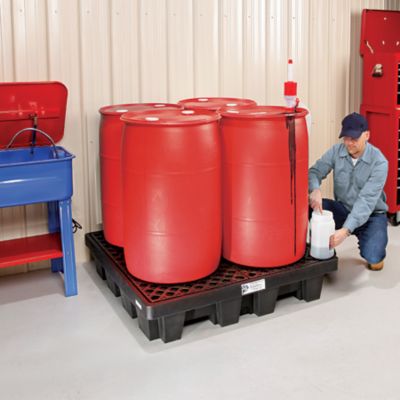Variety is a good thing — it means that consumers have lots of choices. But freedom of choice can be a little frustrating when you're not sure of the

Liquids in Contact
One of the first considerations when choosing a pallet or deck is chemical resistance. Both pallets and decks are available in steel and polyethylene, and chemical resistance guides are available to help determine which materials will be suitable for contact with the liquids being contained.
Steel units are the preferred choice when dedicated bonding/grounding points are required, such as when storing solvents, fuels and other flammable liquids. Steel is also less prone to cracking in cold conditions or softening in high-temperature atmospheres.
Polyethylene units are commonly used for corrosive chemicals, non-flammable liquids, and in areas where temperature extremes are not a factor.
Accessibility
Because pallets and decks are elevated surfaces, ramps, drum lifting devices or forklift attachments that help raise and lower containers are other options to consider. Although it is possible to “bump” the drum up over the edge of some lower height decks, repeatedly doing this can cause the deck to develop stress cracks over time.
Full containment
Spill Containment Pallets are designed to help meet containment regulations. Pallets are available in various sizes, from one drum to eight drum capacities, to help fit a multitude of applications.
When polyethylene pallets are chosen, consider whether or not the unit will be moved while loaded. Heavy-duty pallets are designed to withstand this added pressure, so they won’t bow or crack during transport. Standard-duty pallets are fine for static loads, but are not designed to be moved while loaded.
Good housekeeping
Modular Spill Decks feature connectable sumps that can be used independently to capture nuisance leaks and spills. These units can also be linked together to increase sump capacity and provide spill containment for multiple drums.
Modular Spill Decks are typically preferred when:
- Space is available for linking multiple units together to achieve regulation-required sump capacity
- The unit does not need to be portable
- Low-profile is desired for drum-top accessibility or frequent loading/unloading
- A single device is used for “housekeeping” purposes rather than “containment”
A Product for every need
Because of the versatility of containment pallets and spill decks, there is often more than one product to fit a given need. In some cases, however, a unit may need to be specially designed to fit the application.
Containment systems with collapsible walls and outdoor storage buildings are two such examples. These systems can be custom-designed to fit nearly every need and specification.
Portable containment units help save the time and expense of hiring an engineering firm to create a containment system. They also help save on the cost, downtime and inconvenience of having a contractor install the system at the facility. And, because they are not permanently installed, they can be moved or expanded as the facility’s needs change.
Find out more:
New Pig provides a comprehensive range of Containment Pallets and Decks from our online shop. Or why not give us a call on 0800 919 900.






COMMENTS